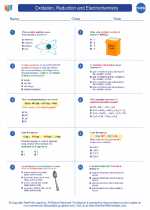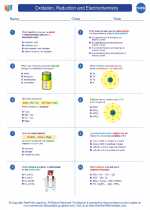Oxidation, Reduction, and Electrochemistry
Introduction to Oxidation and Reduction
Oxidation and reduction are key concepts in chemistry that are often studied together under the umbrella of electrochemistry. Oxidation refers to the loss of electrons by a molecule, atom, or ion, while reduction refers to the gain of electrons by a molecule, atom, or ion. These processes are always coupled - when one substance is oxidized, another is reduced. This relationship is summarized in the mnemonic "OIL RIG" - Oxidation Is Loss, Reduction Is Gain.
Redox Reactions
Redox reactions are chemical reactions that involve the transfer of electrons between reactants. The substance that undergoes oxidation is known as the reducing agent, while the substance that undergoes reduction is known as the oxidizing agent. Redox reactions are fundamental to many natural processes such as respiration, photosynthesis, and corrosion.
Half-Reactions
Redox reactions can be broken down into two half-reactions, one representing the oxidation process and the other representing the reduction process. Each half-reaction shows the transfer of electrons and the change in oxidation state of the species involved. Balancing these half-reactions is crucial for understanding and predicting the outcome of redox reactions.
Electrochemistry
Electrochemistry is the branch of chemistry that deals with the relationship between electrical energy and chemical change. It encompasses the study of redox reactions in electrochemical cells, where chemical energy is converted into electrical energy, or vice versa. Key concepts in electrochemistry include oxidation-reduction potentials, galvanic cells, electrolytic cells, and the Nernst equation.
Study Guide
- Understand the concept of oxidation and reduction, and how to identify them in chemical reactions.
- Learn to balance redox reactions by breaking them down into half-reactions and balancing the transfer of electrons.
- Explore the applications of redox reactions in everyday life, such as in batteries, corrosion, and industrial processes.
- Master the principles of electrochemistry, including the construction and operation of galvanic and electrolytic cells.
- Practice calculating oxidation-reduction potentials and understanding the factors that influence the spontaneity of redox reactions.
By understanding the fundamentals of oxidation, reduction, and electrochemistry, you will gain insights into the behavior of chemical systems and the applications of redox processes in various fields.
.◂Chemistry Worksheets and Study Guides High School. Oxidation, Reduction and Electrochemistry

 Worksheet/Answer key
Worksheet/Answer key
 Worksheet/Answer key
Worksheet/Answer key
